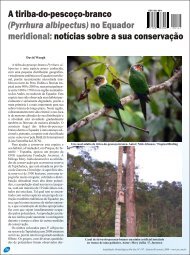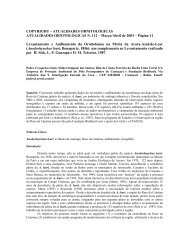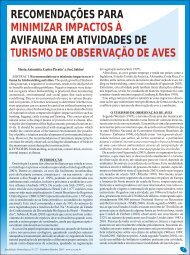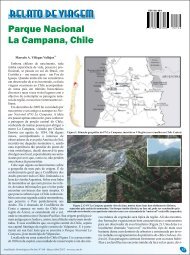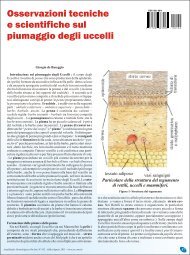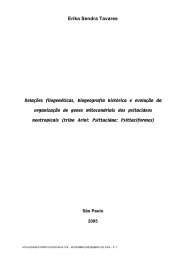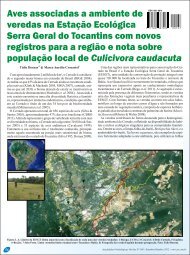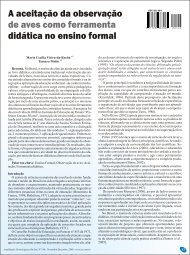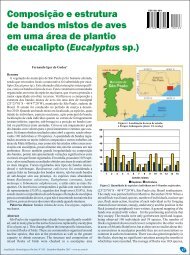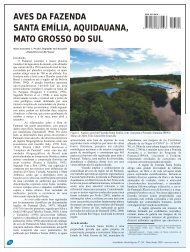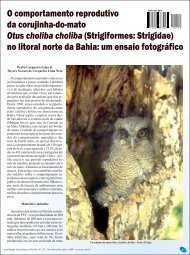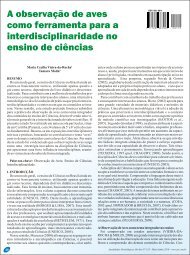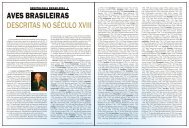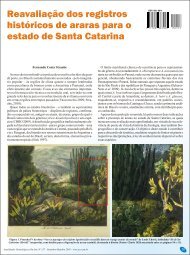História da ornitologia no Paraná. Período de Natterer, 1
História da ornitologia no Paraná. Período de Natterer, 1
História da ornitologia no Paraná. Período de Natterer, 1
Create successful ePaper yourself
Turn your PDF publications into a flip-book with our unique Google optimized e-Paper software.
É o caso, por exemplo, do taperuçu-preto(Cypseloi<strong>de</strong>s fumigatus), cuja indicações toponímicasoriginais baseiam-se em enga<strong>no</strong> <strong>de</strong> seu autor August V.Streubel, conforme corrige Zimmer (1945:587):“There is some confusion with respect tothe type locality of fumigatus which was<strong>de</strong>scribed by Streubel (Isis 5: col.366;1848) from ‗Paraguay‘ (ex <strong>Natterer</strong>) and‗Bresilien‘ (ex Müller), with the namecredit to <strong>Natterer</strong>'s manuscript <strong>de</strong>signatio<strong>no</strong>f a bird presented to the Berlin Museum.There is <strong>no</strong> authentic record of the speciesfrom Paraguay and <strong>Natterer</strong> obtained<strong>no</strong>ne in that country. Burmeister (SystUebers. Thiere Brasiliens , 2:367, 1856)cites <strong>Natterer</strong>'s bird in the Berlin Museumas from ‗Para‘ which is equally puzzling.In the report of <strong>Natterer</strong>‘s collection,Pelzeln (Orn.Bras.: 16, 1868) gives threelocalities for fumigatus of which two are inthe state of São Paulo, and one in <strong>Paraná</strong>(Curytiba), and it seems rather clear thatStreubel's ‗Paraguay‘ and Burmeister‘s‗Para‘ should be interpreted as <strong>Paraná</strong>.Accordingly, I propose the restriction ofthe type locality of Hemiprocne fumigataStreubel to Curytiba, <strong>Paraná</strong>, Brazil‘.“Há uma certa confusão a respeito <strong>da</strong>locali<strong>da</strong><strong>de</strong>-tipo <strong>de</strong> [Cypseloi<strong>de</strong>s]fumigatus, menciona<strong>da</strong> por Streubel (Isis5: col.336; 1848) como „Paraguay‟ (ex<strong>Natterer</strong>) e „Brasilien‟ (ex Müller), cujo<strong>no</strong>me é creditado à <strong>de</strong>signação ofereci<strong>da</strong>pelo manuscrito <strong>de</strong> <strong>Natterer</strong> a partir <strong>de</strong> umexemplar mantido <strong>no</strong> Museu <strong>de</strong> Berlim.Não há nenhum registro autêntico <strong>da</strong>espécie para o Paraguai e <strong>Natterer</strong> na<strong>da</strong>coletou nesse País. Burmeister (Syst.Uebers.Thiere Brasiliens, 2:367, 1856)cita o espécime <strong>de</strong> <strong>Natterer</strong> <strong>no</strong> Museu <strong>de</strong>Berlim como oriundo do „Para‟, algoigualmente confuso. Na revisão <strong>da</strong> coleção<strong>de</strong> <strong>Natterer</strong>, Pelzeln (Orn.Bras. 16, 1868)informa sobre quatro locali<strong>da</strong><strong>de</strong>s para [C.]fumigatus, <strong>da</strong>s quais duas estão em SãoPaulo e uma <strong>no</strong> <strong>Paraná</strong> („Curytiba‟) e,assim, parece claro que o „Paraguay‟ <strong>de</strong>Streubel e o „Para‟ <strong>de</strong> Burmeister <strong>de</strong>vemser interpretados como <strong>Paraná</strong>. De acordocom esse raciocínio, proponho a restrição<strong>da</strong> locali<strong>da</strong><strong>de</strong>-tipo <strong>de</strong> Hemiprocnefumigata Streubel para Curitiba, <strong>Paraná</strong>,Brasil”.82



